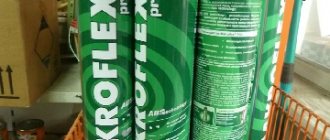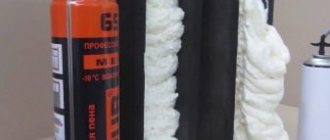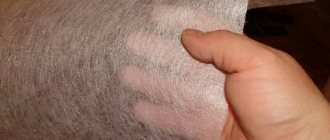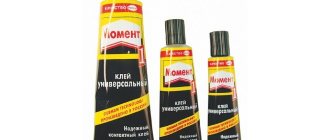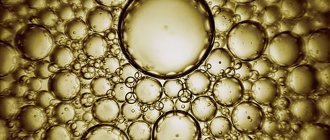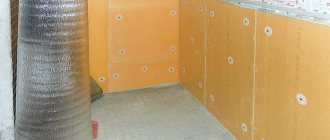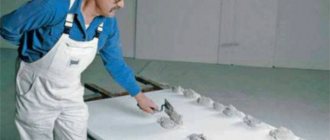How is it different from summer
Polyurethane foams are produced in sealed tubes or cartridges. The cylinder contains a prepolymer of liquid consistency and gas under pressure. In the process of displacing the foam from the tube, the polyurethane expands from exposure to atmospheric moisture and fills the installation gaps. The composition of polyurethane foam for winter work includes special additives that prevent the mixture from freezing at low ambient temperatures. After curing, the porous foam mass hermetically fills the treated voids and cavities.
The main difference between winter and summer foam is compliance with the temperature conditions when applying the sealant. Summer foams cannot be used for outdoor work if the temperature drops below +5 degrees. Therefore, in early spring, late autumn and winter, special frost-resistant compounds are used. Summer sealants do not expand in the cold, so their use at subzero temperatures will be ineffective:
- The mixture does not acquire the required consistency and expansion.
- The foam substance does not form the required hermetic base.
- The mass forced out of the balloon begins to crumble in the cold.
To avoid such troubles and not have to redo the whole job again, craftsmen use winter foam. It can be used at sub-zero temperatures and low air humidity due to the inclusion of special additives in the composition.
Note: Winter foams can be used in the summer - assembly sealants retain their properties in hot and dry weather.
Peculiarities
The quality of the craftsman’s work directly depends on the characteristics of building materials. Several years ago, when installing plastic windows and external doors, builders actively covered the cracks with summer foam. Consumers noted that after 1-2 cold seasons, the joints began to blow, drafts appeared, and the room temperature dropped. When analyzing the problem, it turned out that the sealant had lost its properties and had become so porous that it was difficult to hold the structure in place.
The reason lies in the incorrect selection of polyurethane foam. Standard series are designed for a temperature range from -10° to +30°C. During severe winters, the structure of the sealant is disrupted and allows water and air to pass through. The sealant deteriorates faster, so it requires mandatory isolation with a layer of grout, putty and paint. In winter conditions, it is better to select special types of material adapted for more extreme conditions.
Polyurethane foam for working at sub-zero temperatures has a number of features:
- easily tolerates changes from -50° to +80°C;
- does not thicken when installed in light frost;
- hardens equally quickly in cold or heat;
- has excellent thermal conductivity and sound insulation;
- allows you to save up to 10% of heat in the room.
The appearance of winter foam has made the task easier for many builders. With its help, you can carry out installation work in cold weather, and perform urgent installation of a window unit at low temperatures. But the choice should be approached more carefully, study the characteristics and strictly adhere to the recommendations of experienced specialists.
Features of using polyurethane foam in the cold
Frost-resistant compositions for installation work do not lose their quality at temperatures of -10-25°C. When the prepolymer is forced out of the tube, the volume of the mounting agent increases tens of times, which makes it possible to perform large-scale work with one container of winter mounting foam.
Features of using the foam substance in the cold:
- When the composition is forced out of the tube, the mass first shrinks and is retracted. But under the influence of sub-zero temperatures, the viscosity of the material increases.
- After applying the polyurethane sealant, the mass gradually increases in volume. Due to the negative temperature, the pressure in the cells of the substance decreases and the expansion process slows down.
- In the process of increasing the volume of the mounting sealant, it is impossible to influence the mass mechanically. The material remains brittle for 3-6 hours.
During polymerization, the foam absorbs atmospheric moisture. In severe frost, air humidity is low and the rate of hardening decreases. If you use winter formulations at a temperature of +20 degrees, the foam yield will be about 45 liters, and the initial hardening time will be 1-1.5 hours. At zero air temperature, the amount of foam when displaced from the tube will decrease to 35 liters, and the primary expansion lasts 3-6 hours. If the temperature outside is -10 degrees, the foam yield will be up to 25 liters, and you can cut off the excess mass in 5-9 hours.
Important: The viscosity of the foam increases in cold weather, so part of the mixture sticks to the walls of the cartridge and is not forced out of the tube. This point must be taken into account when calculating material consumption.
Dynamics of expansion of polyurethane
The cylinder, in addition to the prepolymer, contains a mixture of propellant gases pumped into it under pressure. Because of this, they are in a liquid state. When the cylinder valve is opened, the liquefied gas rushes out, carrying the prepolymer with it, and instantly boils. The volume of gas injected under natural conditions determines the volume of foam at the outlet.
Due to the rapid release of the propellant, the prepolymer is forced out of the cylinder and receives initial instant foaming. Further formation of bubbles in the composition occurs due to carbon dioxide released when the polymerization reaction begins.
For Makroflex household foam, light gases are used as a propellant, which significantly increase in volume when boiling. But at the same time, the density of the material is low (25 kg/m3), which affects the strength characteristics. Foam consists of large homogeneous cells. The expansion coefficient of household winter foam Makroflex Winter is 1:50.
Household polyurethane foam requires trimming, since its volume usually exceeds the size of the space to be filled. This type of material is not used for installation work, but only for sealing and sealing.
Professional Makroflex foam has a high coefficient of primary expansion, and its high density (25-30 kg/m3) allows the composition to be used during installation work. The structure of the foam is small cells of the same size. The professional foam at the output exceeds the original volume by almost 65 times.
Due to the controlled supply, the material in professional cylinders receives instant expansion not on the surface, but in the nozzle of the gun; it enters the sealed area in almost its final volume. Therefore, professional foaming is more economical and accurate.
Inside the cylinder, the prepolymer and liquefied gas separate over time, and for better diffusion of molecules, the foam must be shaken before use. Otherwise, only gas will come out of the cylinder, and the prepolymer will remain inside.
Currently, instead of freon, gases that do not destroy the ozone layer of the atmosphere are used. For example, Tytan Professional O2 polyurethane foam has a characteristic icon in its name.
Specifications
Domestic and foreign manufacturers produce a wide range of installation sealants for winter application conditions. Products differ in cost, properties, and service life. The majority of products are suitable for application at temperatures of -10+35 degrees. Some foams can be used at -30°C.
Technical characteristics of sealants:
- The average foam yield from a 300 ml bottle is 30 liters or more. The volume of the substance is affected by negative temperature.
- Assembly sealants are characterized by primary and secondary expansion. The coefficient varies from 30 to 50%.
- The porosity of the hardened installation mass is 80-90%. High-quality foam is evenly filled with porous cells
- High adhesion to building materials - brick, concrete, metal, wood, porcelain stoneware, natural stone.
- Viscous consistency - the higher this parameter, the stronger the sealant adheres to surfaces of different structure and porosity.
- The polymerization time of winter foam varies from 4 to 10 hours. Drying speed is affected by temperature and humidity.
Foam is applied to joints and gaps to a third of the volume of voids. After primary expansion with the formation of the upper dried layer, the sealant fills the entire cavity, and after a few hours secondary expansion or shrinkage occurs. For high-quality compositions, shrinkage should not exceed 4%. If this parameter is higher, gaps appear in the foam, violating the tightness of the layer. On the tube with winter foam, manufacturers indicate the expansion coefficient, yield from the container, shelf life and additional technical characteristics.
Attention: It is not recommended to cut off winter foam applied at sub-zero temperatures earlier than one day later. The mass should dry completely.
Features of the selection and use of winter polyurethane foam. Review + yield test of winter foams 2021
What is the difference between winter and summer installation? – In air temperature and humidity
. If everything is clear with temperature, then you should talk in more detail about humidity.
Air humidity is the main factor determining the quality of polyurethane foam polymerization. The rate of polymerization, the density of the seam, the volume of foam at the outlet, and the coefficient of primary and secondary expansion depend on air humidity.
The ideal air humidity for polyurethane foam is 50% or more.
In winter, air humidity becomes 20 times less. The air becomes very dry. Summer polyurethane foam in such conditions cannot provide high-quality installation, heat and sound insulation, since it is designed to work in other weather conditions.
The use of summer polyurethane foam at subzero temperatures entails:
– High fluidity of foam
– Voids and “shells” inside the seam
– Weak expansion
– Increased polymerization time
– Low strength indicators
In order to avoid all possible problems associated with the use of polyurethane foam in the winter, manufacturers produce special winter polyurethane foam.
Winter polyurethane foam contains special additives - fluorocarbonate and catalysts, which make it suitable for use at low temperatures and low air humidity.
TOP – 9 winter polyurethane foams
STMarkt's assortment includes a wide range of professional winter polyurethane foams that have successfully proven themselves in the construction chemicals market:
Sila TopGun 70 WINTER
Source: https://zen.yandex.ru/media/stmarkt/osobennosti-vybora-i-primeneniia-zimnei-montajnoi-peny-obzor—test-na-vyhod-zimnih-pen-2020-goda-5e1d831a6f5f6f00ae02fb6d
Kinds
To choose winter foam, you need to take into account the properties and features of the compositions. Foams are classified into one- and two-component foams, which are characterized by faster hardening. Sealants differ according to the principle of use, temperature conditions and technical characteristics.
Classification of winter foams into types according to a number of characteristics:
- By appointment. Professional sealants are applied using a construction gun. Advantages: dense structure, minimal secondary expansion. Household foams can be applied through a special plastic tube with which the tube is equipped. Semi-professional (household) compositions are used for one-time home repairs. The density of cured polyurethane is lower, and the secondary expansion process can cause shrinkage.
- By flammability class. Fireproof winter foam B1 for special purposes is used for the installation of fireproof doorways, the construction of fireplaces and stoves. Pink fire-resistant foams resist fire for 6 hours. The second type is self-extinguishing sealants B2. They cannot withstand open flames. B3 combustible foams are ordinary winter sealants, do not resist fire, and melt in the event of a fire.
- Based on the temperature of use, foams are classified into summer, all-season and winter. Summer sealants are used at +5 degrees and above. All-season products can be used at subzero temperatures. But if you need a composition specifically for application in the cold season, it is better to use winter sealants designed for this purpose. The temperature of the container during application should not be negative.
Winter foams are produced in tubes of various sizes. The most popular packaging is a 300 ml cartridge for a pistol. For critical installation work, it is better to use professional compounds. Household sealants equipped with a tube are less reliable and convenient to use. If the foam is of poor quality, the gas may run out earlier and not all of the prepolymer will activate.
On the video: Polyurethane foam summer/winter difference.
Disadvantages of polyurethane foam
The most significant drawback is sensitivity to ultraviolet radiation. Under its rays, polyurethane loses its properties and is destroyed, so the foam must be either puttied or protected from direct sunlight.
One of the positive qualities of polyurethane - chemical inertness - also has a negative side, since after drying no solvents will create foam. Therefore, it makes sense to use acetone cleaners to remove hands that have gotten on the surface only before the material dries. If the foam has hardened, remove it mechanically using pumice.
With the help of polyurethane foam, many problems are quickly and effectively solved in construction today. The wide variety of these products allows them to be successfully used in a wide variety of conditions.
Scope of application
The area of use of polyurethane foams is very wide, covering various areas of industry; the compositions are used for domestic needs. Winter sealant has good adhesion, firmly adheres to various materials and can withstand low temperatures without losing its properties.
Where frost-resistant, cold-resistant polyurethane foam is used for external and internal work:
- Installation of boxes for entrance structures.
- Installation of plastic and wooden windows.
- Foaming the gaps of interior doors.
- Sealing of facades and interpanel seams.
- Insulation of pipeline joints, plumbing.
- Installation of heating equipment, fireplaces.
- Fixation of materials for facade insulation.
- Isolation of communications and cable channels.
- Foaming of deformed surfaces.
Winter foams “work” effectively as sealing or fixing agents. The compositions quickly fill voids, holes, cavities and technological gaps. With their help, you can eliminate defects in concrete walls and cement screeds.
Note: Foam can be used as insulation when constructing plasterboard partitions, and heat-insulating materials can be glued onto it to fix wall panels and sheet insulation.
Polyurethane foam - properties, types, application, recommendations for use
When repair work cannot be postponed and temperature conditions are below 0˚C, polyurethane foam for sub-zero temperatures is used. This sealing compound allows construction and installation to be carried out continuously all year round. How to use this material correctly, what types and technological features there are, we will consider in the article.
What happens in winter when applying polyurethane foam
Due to the reduced amount of moisture in the air in winter, the period of polymerization and curing of polyurethane foam increases several times. All this time, the applied foam-like mass is very vulnerable: due to wind, rain, and mechanical influences, irreversible processes occur in it that disrupt the structure. The foam becomes brittle, cracks and crumbles.
Winter polyurethane foam contains special additives that increase the rate of its polymerization and help maintain the correct consistency in frost and low humidity. This building material differs from the usual one in the ratio of chemical components and is intended for use in the cold season at temperatures down to −10 ° C.
In winter, you can only use special polyurethane foam
Popular brands
Let's analyze the polyurethane foam from the most popular manufacturers:
ULTIMA.
A good Russian brand of summer foam. Perfectly suited for all types of work in large volumes. Withstands repeated sudden large temperature changes and high humidity. Meets the highest requirements.
Makroflex.
A very popular brand. The foam yield indicated on the can is equal to the actual yield. Very good adhesion, uniformity. The downside is that due to its popularity, you should beware of fakes.
Moment Installation
. A common budget brand, it has a dense, uniform structure. The downside is that after 2-3 years of use it loses its elasticity.
Soudal.
The structure is fine grain, there is no shrinkage, the quality is high. The downside is that it is not widely available and difficult to purchase.
To summarize, we can conclude that when purchasing polyurethane foam from a popular brand, you need to beware of counterfeits. Basically, well-known manufacturers produce high-quality materials that meet the necessary requirements.
The fundamental difference between summer and winter polyurethane foam
- Summer – intended for application at temperatures from +5 to +35 °C. After complete hardening, it can withstand a completely different temperature range - from −50 to +90 ° C. The restriction is only relevant when working with the material.
- Winter - applied at temperatures from −10 (−18) °C to +35 °C without compromising performance.
There is also an all-season variety that quickly polymerizes at temperatures down to −10 °C. It can be used both in summer and winter.
However, not all manufacturers have such universal sealing materials in their product lines. In addition, with lower thermometer readings, the risk of cracking of the mass increases.
Scope of application
Winter polyurethane foam has a wide temperature range, so it can be used not only outside, but also inside heated rooms.
Namely:
- Fixation and sealing when installing window, door blocks and entrance structures.
- Sealing of plumbing communications and equipment.
- As a filler for filling voids and cracks in the space between walls.
- Thermal insulation for heating and heating systems.
- Insulation during installation of electrical networks.
- Sound insulation and fixation of plasterboard wall panels.
What happens if you use standard polyurethane foam in winter?
You should not be surprised that the technical indicators of standard foam, stated by the manufacturer in the instructions, are very different from the real ones. At temperatures below +5 °C, the mass will harden much longer than it should, which will negatively affect its performance:
- the composition will not reach the desired consistency;
- the strength of the seam will suffer;
- the foam-like mass will begin to crumble as it hardens.
Summer polyurethane foam crumbles and cracks under the influence of low temperatures
Stages of work
The foam is used step by step like this:
- The surface is cleaned of small debris, if any.
- The surface is degreased (acetone).
- The surface is moistened (sprayed with water using a brush or spray). Foam hardens faster and better if the surface (or air) is wet.
- If the room is cold, place the balloon in warm water.
- The cylinder is opened, inserted into the gun (or a tube is put on it) and shaken.
- The end of the tube is inserted into the slot, and the foam is supplied in portions, 5-10 cm along the length of the slot, moving from bottom to top.
- After complete hardening (after 25-30 minutes), the protruding pieces are cut off with a construction knife.
Safety precautions when working with polyurethane foam
Polyurethane foam is a chemical composition located in a container under pressure. Therefore, you need to work with it, observing safety rules:
- Do not drop or heat the cylinder.
- Do not use the cylinder near hot surfaces or open flames.
- The work is carried out with gloves (if the foam gets on the skin, it will be difficult to clean it off).
- You need to keep a sponge and a rag on hand to clean off the composition if it gets into an “unwanted” place.
Removing foam from contact with “unnecessary” surfaces
Polyurethane foam sets quickly on the surface, so if it gets somewhere other than the desired gap, it will be difficult to clean it off.
Methods for cleaning different surfaces:
- Leather. If the composition has not hardened, it is removed with a sponge, and the remains are washed with acetone or a solvent. If it is frozen, it is cut off and scrubbed off with a scrub.
- Textile. The uncured composition is collected with any hard object (a piece of a board will do). The frozen pieces are cut off, and small residues are washed off with a solvent. In both cases, a stubborn stain may remain on the fabric.
- Plastic window sills, frames, slopes. The fresh composition is removed with a sponge, the remains are washed off with a cleaner for plastic surfaces. The dried layer is cut off, the remains are washed off.
- Linoleum, laminate. Fresh foam is removed with a hard object (spatula, piece of board), the remains are collected with a sponge soaked in cleaner.
To prevent such situations, in addition to the skin, it is necessary to protect the surfaces around it. It is advisable to cover them with plastic wrap, rags or newspapers.
Advantages of winter polyurethane foams
Winter polyurethane foam is used to seal windows and doors, gaps in walls and partitions made of concrete, brick, wood, metal and plasterboard.
- It hardens and retains its performance properties at temperatures down to −10 °C (REALIST 70 polyurethane foam - up to −18 °C) and low ambient humidity.
- Has excellent adhesion to smooth surfaces, painted walls, glass or PVC.
- Suitable for sealing even wide and deep cracks and joints.
- It has high sound and heat insulation characteristics.
- Used if necessary all year round, including in summer.
Winter polyurethane foam cannot be applied to oily surfaces, polyethylene, polypropylene, silicone, Teflon - it will not provide strong adhesion. A suitable base must be free of ice.
Specifications
Technical characteristics of polyurethane foam:
- Extension. Indicates the volume that the mixture occupies at 2 stages: leaving the container and solidifying. The greater the expansion, the denser the gap (seam, hole) will be foamed. Average figures are 10-60% for household compositions, and 180-300% for professional compositions.
- Adhesion. Indicates the tenacity of the composition with the surface inside the foamed space. The higher the viscosity, the less the foam will slide off. This is relevant if you need to foam holes on a vertical surface (on the wall) or on the ceiling (from where the foam can drain before it hardens). In numbers, the normal parameter is considered to be 0.4-0.48 MPa.
- Volume in container and volume out. Common parameters: 300 ml (will give about 30 liters of hardened foam), 500 ml (will give about 40 liters of foam), 750 ml (will give up to 50 liters of foam) and 1000 ml (80-100 liters). The volume of frozen foam is given approximately under normal conditions (room temperature).
- Temperature at which foam can be applied.
These characteristics are indicated on the cylinder.
Source: https://grand-haus.ru/vidy-kleya/letnyaya-montazhnaya-pena-zimoj.html
How to use
In order to carry out installation work efficiently, you need to know the basic rules for using winter polyurethane sealants. A prerequisite is that if the cylinder was brought from the cold, it must be kept for some time at room temperature (at least 12 hours). When performing outdoor work in winter, the surface to be treated should be cleared of ice, snow, frost, and dirt, which reduce the adhesive characteristics of the sealant.
How to use winter foam correctly:
- After preparing the base, shake the foam container, open the sealed packaging and fix the cartridge on the gun.
- When foaming joints and seams, the tube should be held upside down. Filling the gaps is carried out to a third of the volume.
- Winter frost-resistant polyurethane foam can be applied to the surface in several layers after the previous layer has hardened.
- The foam is afraid of sunlight; the treated surfaces are covered with polyethylene before applying the finishing coating.
- The optimal temperature for using sealants is +10 degrees, but application is allowed at -10-25°C (indicated on the tube).
- Foam adheres better to moistened surfaces, but large accumulations of moisture should not be allowed.
- You can cut off excess mounting compound after a day, when the polymerization process of the substance is completely completed.
Before use, the tube with winter foam should be shaken vigorously for 20-30 seconds. Then the components (gas and prepolymer) will mix well, and the mass will easily come out of the container. It is recommended to wear glasses and gloves to prevent sealant from getting on your skin or eyes.
Temperature and technology for using winter polyurethane foam – Repair and construction
Nowadays, any construction or repair work is rarely completed without the use of polyurethane foam. Many people consider it a type of sealant, although in fact this is not entirely true, and the purpose of polyurethane foam is much broader. Sealants are used to seal seams and joints up to 30 mm wide, and polyurethane foam is used for cracks wider than 30 mm.
Builders value foam for the following qualities:
- with its help you can fasten individual parts of the structure together;
- foam has high soundproofing and thermal insulation properties;
- with its help you can seal even wide and deep cracks and joints.
Polyurethane foam (MP) – composition and properties
The material is sold in cylinders that contain a liquid prepolymer and a propellant that pushes it out of the cylinder.
The contents released from the cylinder actively interact with atmospheric moisture and moisture contained in the material that makes up the treated surface.
In this case, an active polymerization reaction occurs, during which the foam hardens (freezes).
The result is a rather rigid substance - polyurethane foam, which fills the entire seam, as well as hard-to-reach joints and cavities.
Moreover, the foam is designed to work with almost all building materials with the exception of polypropylene, polyethylene, silicone, Teflon and similar materials. Since the material becomes self-hardening when leaving the cylinder, working with it is quite simple and convenient.
Previously, wide cracks were sealed with tow mixed with cement (without any guarantee of achieving the required sealing result). At the same time, the process was gradual, and therefore quite lengthy and labor-intensive.
Using a foam container allows you to carry out the same work in one pass, that is, quickly and with a guarantee of the desired result.
All these advantages make foam a versatile material that has hundreds of uses in the construction industry.
When working with polyurethane foam, you need to know its advantages and disadvantages.
The advantages of MP include:
- High coefficient of expansion of the material, allowing you to perform a large amount of work with one can of foam.
- Sealing the seam with foam simultaneously increases its sound and heat insulation characteristics.
- MP does not conduct electricity and is not afraid of moisture.
- There are several types of foam on sale, which can be divided according to the degree of fire resistance (B3 - flammable material, B2 - self-extinguishing material, B1 - fire-resistant). Therefore, it is possible to choose a material depending on the operating mode of the sealed structures.
The material also has disadvantages:
- The main disadvantage of MP is its instability to ultraviolet radiation - when exposed to it, the polymer begins to deteriorate, for this reason the treated seams must be protected from light by puttying or painting.
- Cylinders must be stored in a cool room, since when exposed to high temperatures, the pressure in them increases, which can lead to the explosion of the can and damage to all nearby materials.
- Once on the skin, the foam is very difficult to remove. It can only be washed off with a special solvent. Therefore, you need to work with gloves. If the foam still hardens on the skin, you will have to steam the area and then clean it off with a pumice stone.
Types of polyurethane foam
All foam offered at points of sale is divided according to several criteria. Depending on the method of use, it can be semi-professional or professional.
Semi-professional is used without any additional devices. To apply it, use a plastic tube with a lever included with the cylinder, which is placed on the cylinder valve. Professional foam requires the use of a special gun, which allows dosing of the supplied jet, and is also convenient for working in hard-to-reach places.
Based on temperature of use, foam is divided into three types:
- summer The container with summer foam indicates that the surface temperature of the structure being treated can be from +5 to +35 degrees. But at the same time, the hardened foam has temperature resistance from -50 to +90 degrees. That is, the limitation concerns only the immediate moment of application of the material;
- winter Winter foam is used when carrying out work in winter. The temperature range allowing the use of this foam is from -10 (-18) to +35 degrees. When using winter foam, you need to take into account that its volume after leaving the cylinder strongly depends on the ambient temperature - the lower its temperature, the lower the foam yield. Thus, foam consumption may increase;
- all-season. All-season foam combines the properties of the two previous materials. It has a special formula that allows you to get a large volume of foam even at low temperatures. In this case, the material quickly polymerizes even in the cold. This is still a fairly new material, which is not produced by all MP manufacturers.
Winter foam - characteristics and application features
Since the expansion and polymerization of MP depend on the temperature and humidity of the surrounding atmosphere, winter foam tends to harden at low temperatures, but its expansion during the polymerization process is weaker than that of summer foam.
Main characteristics of winter foam:
- Output volume - this indicator determines the amount of material obtained from one cylinder. Compared to conventional foam, it can be 1.2-1.5 times less.
- Adhesion - determines the strength of the bond between the base and the foam. This indicator is practically no different from that of summer foams.
- Dwelling time is the time during which the foam completely cures. Sub-zero air temperatures and low temperatures of the building structure itself require longer exposure of the foam after application. Moreover, the lower the temperature, the longer the holding period should be. This is important to consider as the reduced expansion of winter foam may require multiple passes to treat the seam. The next layer of foam is applied only after the previous one has completely polymerized.
Technology for using special winter foam:
- Before starting work, the cylinders must be kept in a warm room for at least half a day. Some manufacturers recommend heating the balloon in warm water at a temperature of 30-50 degrees before use. However, the most advanced manufacturers may not give such recommendations - their foams already contain substances that increase the volume of the mixture leaving the cylinder. In any case, you need to carefully study the instructions on the bottle label.
- Surfaces to be treated must be cleaned of dust, debris, snow and ice. It is allowed to lightly moisten the surfaces with water using a spray bottle (immediately before carrying out work).
- Before using the foam, the container must be shaken for 15-30 seconds - this promotes better mixing of the foam components and increases its yield.
- The work is carried out by holding the cylinder upside down. The cracks and seams must be carefully filled with foam to about 1/3 of the volume. Please note that the composition will expand during polymerization, so do not waste excess foam.
- If necessary, after the first layer of foam has hardened, subsequent ones can be applied.
- The use of winter foam in cold weather does not imply its subsequent spraying with water in order to improve adhesion (this is allowed in summer).
- Cured foam must be protected from light and sun as soon as possible, otherwise it may become porous and brittle, reducing its protective properties.
Most winter foams have a lower threshold for use of –10 degrees. But there are manufacturers who produce foams that can be used down to -25 degrees. One of these is Soudal - a product of this.
Regular winter foam of the Macroflex brand can be used at temperatures down to –10 degrees. Also an excellent winter foam, used down to –20 degrees, is Tytan Professional 65 (cylinders with this material do not need to be heated before use).
In any case, carefully read the manufacturer's recommendations regarding the use and storage of foam. This way you can achieve high tightness of the seams at any time of the year.
Source: https://remontiks.com/materialy/zimnaya-montazhnaya-pena.html
Storage rules
The shelf life of winter foam in sealed original packaging is on average 12 months. An open container must be used to the end. The sealant must be stored in an upright position to prevent components from clogging the valve. Winter foam should be used only at the temperature indicated by the manufacturer on the packaging, otherwise the sealant will lose its properties.
Important: Winter foam cannot be stored at subzero temperatures - its technical characteristics are lost.
Main types and scope of their application
Two types of foam:
- Semi-professional;
- Professional.
The first type includes foam, which does not require the use of additional devices. The substance is sprayed through a special tube with a lever - adapter.
This tube comes complete with the cylinder and fits onto the valve.
More often, the presented type is used to perform a small scope of work. If there is foam left in the container after use, it should be stored until the next use. Clean the tube with a special solution or regular acetone.
Professional or pistol (as the manufacturers dubbed the product). It is sprayed with a special gun, which doses and delivers (squeezes out) the material itself. The cost of a mounting gun is several times higher than the price of the foam itself, so it is not practical to use this type of material for one-time foaming.
Foam gun
Manufacturers
Frost-resistant installation sealants are produced by various manufacturers of building materials, including foreign and domestic brands. High-quality winter foam has good primary expansion, uniform porosity, and a dense structure.
The following compositions have proven themselves well:
1. Well-known brand Soudal, which is one of the largest manufacturers of aerosol winter foams. Advantages: homogeneous consistency, good thermal insulation properties. Sealants have a long service life.
2. The Penosil brand has gained wide popularity among consumers. Winter formulations of this brand have insignificant secondary expansion, a high coefficient of mass release from the tube, and economical consumption.
3. Tytan Professional winter foams are designed for use at air temperatures down to -20 degrees. The manufacturer’s environmentally friendly compositions have a dense, fine structure; after hardening, shrinkage does not occur.
Winter foams Ultima, Axton, and Macroflex received good customer reviews. Before purchasing, you need to carefully read the operating conditions and application of sealants. The modern construction market offers a wide range of frost-resistant foams, so there are no problems with the choice.
Winter polyurethane foam (2 videos)
Types and use of winter foam (18 photos)
Characteristics
The widespread use of polyurethane foam is, first of all, due to its performance characteristics, which make it possible to consider this material indispensable in almost all types of construction work. The main properties of polyurethane foam, at the same time recognized as its advantages, which every builder could appreciate, are as follows:
- Possibility of use as a sound and heat insulator;
- High resistance to moisture and low electrical conductivity;
- The operational features of some types of polyurethane foam indicate resistance to fire;
- The ability, after expansion, to fill voids and various cracks, ensuring high quality seams and joints;
- Possibility of gluing elements made of various materials using polyurethane foam.
What temperature can it withstand?
The use of a specialized product is required if there is a significant decrease in winter temperatures to negative levels in the construction area.
In another case, durable polyurethane foam is needed if foaming work is carried out in cold weather. Recommended temperature for using polyurethane foam:
- Some brands work well at -10°C, other manufacturers indicate the application limit at -18°C, and even -20°C.
- With the correct application technology, hardened foam retains its quality characteristics when the temperature drops to -35°C.
- The insulator cylinder must have a positive temperature (+5°C) during installation.
Valera
The voice of the construction guru
Ask a Question
Reducing the temperature below -10°C reduces the yield of foam from the container. This limit is considered optimal for applying a winter insulator. In this case, the material will retain its thermal insulation, waterproofing and noise-absorbing qualities.
Precautionary measures
During repairs and during operation of the substance, it is necessary to take into account not only the properties of the polyurethane foam, its pros and cons, but also observe safety precautions. The main ones:
- The mixture must be used in well-ventilated areas, since its polymerization releases butane and carbon dioxide, which are toxic to humans.
Polyurethane foam is a very necessary and useful thing for repairs, construction, and installation of structures. It can act as a sealant, provide good noise protection, and retain heat. Therefore, it is necessary to approach the choice of substance correctly and consciously, and buy only high-quality products. It is very important to follow the instructions for use to ensure quality and reliability.
Rules for use and technical characteristics of polyurethane foam
Review of manufacturers and mounting foams for winter
1. Macroflex polyurethane foam.
Characteristics:
- minimum application temperature – minus ten;
- secondary expansion - less than fifty percent;
- polyurethane base;
- dimensional stability – +/- five percent;
- holding time at minimum temperature – ten hours;
- foam yield at minimum temperature is twenty-five liters.
- allows you to create sound insulation;
- the temperature of the cylinder during application is from +5 to 25 degrees.
2. Winter polyurethane foam Soudal (“Arctic”).
Characteristics:
- minimum application temperature – minus twenty-five degrees;
- the yield of the substance at a minimum temperature is thirty liters;
- holding time at minimum temperature – twelve hours;
- The maximum heating temperature of the cylinder is fifty degrees.
Winter polyurethane foams are available in manual and professional versions (cylinders for a gun). Using products in winter does not affect their quality and performance characteristics. It is important to follow the instructions supplied by the manufacturer.
Popular manufacturers
Russian manufacturers are actively involved in the production of this popular product:
- Proflex is a Tula company that has been operating for more than 15 years and produces household and professional foam aerosols.
- Vlad PromPen LLC is a well-known company. The company's products have an optimal ratio of quality and cost.
- Premium (De Luxe LLC) . The products are characterized by high performance properties, effective expansion, and excellent adhesion thanks to innovative technologies.
- "Premium product" The company has been operating since 2014, the production is highly specialized, aimed only at the production of foam.
- Kudo (JSC Elf Filling) - the company has developed the Home and Proff lines, the products are distinguished by good yield, hardening speed, resistance to moisture, and combustion.
Foreign manufacturers and brands: Soudal, Penosil, Dr.Scenk.
What happens if you use standard polyurethane foam in winter?
You should not be surprised that the technical indicators of standard foam, stated by the manufacturer in the instructions, are very different from the real ones. At temperatures below +5 °C, the mass will harden much longer than it should, which will negatively affect its performance:
- the composition will not reach the desired consistency;
- the strength of the seam will suffer;
- the foam-like mass will begin to crumble as it hardens.
Summer polyurethane foam crumbles and cracks under the influence of low temperatures
